Cured salmon eggs are a prized bait among anglers targeting salmon, trout, and steelhead. When cured properly, salmon eggs become firmer, more durable, and infused with fish-attracting scents that get finicky biters to strike. While there are various curing methods, using a basic salt cure consistently produces excellent results. If you want to make your own top-quality cured salmon eggs at home, this comprehensive guide will walk you through the entire process step-by-step.
Why Cure Salmon Eggs?
Fresh salmon eggs are extremely perishable, often lasting just a few days if kept refrigerated Curing preserves the eggs by reducing moisture content and preventing spoilage In addition to extending shelf life, curing offers several other advantages
- Firms up the eggs so they stay on the hook longer
- Enhances natural scent to interest more fish
- Adds fish-stimulating flavors while removing fishy odors
- Produces a vivid pink-orange color that appeals to fish
- Allows storage for months in the fridge or freezer
With these benefits, it’s easy to see why so many anglers make their own cured salmon eggs. Once you try this bait, you may never want to fish with anything else!
Gather the Right Curing Supplies
Curing salmon eggs at home is a simple process, but having the right supplies is key for success. Here’s what you’ll need:
- Fresh salmon eggs (loose or in skeins)
- Non-iodized salt (pickling, canning, or kosher salt)
- Containers with lids (plastic or glass)
- Paper towels
- Measuring spoons
- Gloves (optional)
- Sugar, borax, or other optional additives
Make sure to use non-iodized salt, as the iodine in regular table salt can negatively impact the curing process Canning or pickling salt without additives is ideal
Step-By-Step Curing Instructions
Follow these simple steps to transform fresh salmon eggs into a top-performing bait with the help of salt:
1. Prepare the Eggs
Rinse the eggs thoroughly under cold water to remove any debris blood or ovarian fluid. Patting them dry with paper towels. If using loose eggs, gently separate any remaining connective tissues.
2. Apply the Curing Salt
Add a thin layer of salt to the bottom of your container. A ratio of around 1/4 to 1/2 cup of salt per pound of eggs generally works well. Place a single layer of eggs on top of the salt.
3. Layer the Salt and Eggs
Keep layering salt and eggs until the container is full, making sure the eggs are liberally coated. Finish with a layer of salt on top.
4. Mix and Refrigerate
Gently stir the egg and salt mixture together, then cover and refrigerate for 24-48 hours. Periodically massage the mixture to distribute the salt evenly.
5. Rinse and Dry
Once cured, thoroughly rinse the eggs with cold water and pat dry with paper towels before use. Discard any remaining liquid.
gauging curing time
The length of curing time affects egg firmness and color. For best results:
- Cure for 24 hours at minimum.
- Check eggs at 24 hour intervals for desired firmness.
- Larger eggs may require longer curing times of 48 hours or more.
- Avoid over-curing, which can toughen eggs.
When properly cured, the eggs will be firm yet slightly pliable, with a vivid pinkish-orange hue. If the eggs are still soft after 24 hours, continue curing and checking periodically until they reach the right firmness. Refrigeration temperature impacts curing speed, so make adjustments as needed.
Storage and Preservation
For short term storage, cured eggs will keep for 1 week refrigerated in a sealed container. For long term storage, spread the eggs in a single layer on a tray and freeze individually before transferring to an airtight freezer bag. Properly frozen eggs can last for months.
Adding a small amount of borax to the salt cure can help extend shelf life. Other preservatives like sugar and salt also limit bacterial growth. Maintaining a low fridge temperature and minimizing air exposure helps prevent spoilage.
Customizing Your Cure
While salt alone can cure eggs, adding other ingredients allows you to create unique bait blends. Consider incorporating:
-
Sugar – Enhances scent/flavor. Use white sugar or try brown sugar or honey for added depth.
-
Borax – Preservative that firms up eggs. Add sparingly, 1-2 tbsp per pound of eggs maximum.
-
Garlic or Anise Oil – Boosts attractant properties. Just a few drops per pound of eggs is plenty.
-
Coloring – Dyes like cherry Kool-Aid powder or commercial egg colors.
-
Scent – Fish oils, shrimp powder, tuna emulsion, anise. Use subtle amounts to avoid overpowering.
Experiment with small batches using measured amounts of additives. Keep detailed notes so you can replicate your perfect recipe again and again.
Troubleshooting Common Curing Problems
Soft, mushy eggs – Under-curing. Increase salt ratio and/or curing time.
Brittle, crumbling eggs – Over-curing. Use less salt and shorten curing time.
Bland scent and flavor – Insufficient additives. Try incorporating sugar, borax, or scent ingredients.
Eggs sticking together – Inadequate drying. Dry eggs thoroughly after curing and before storage or freezing.
White, opaque eggs – Salt overexposure. Reduce salt ratio and avoid over-curing.
Mold growth – Too much moisture. Pat eggs very dry after curing and eliminate air exposure in storage.
Tips for Rigging and Fishing Cured Eggs
To maximize your fishing success with cured salmon eggs:
-
Thread single eggs or small clusters onto bare hooks.
-
Add lightweight float, split shot, and bait holder when drifting eggs.
-
Hide the hook point with a small piece of worm or plastic bait thread.
-
When bottom fishing, mold eggs around the hook in a bait ball.
-
Carry eggs thawed and premixed with borax to keep them firm.
-
Match hook and egg size to the species you’re targeting.
-
Experiment with egg colors; brighter hues can help grab attention.
With the right rigging approach, cured salmon eggs catch fish after fish. Follow the curing and preparation tips in this guide and you’ll have amazing bait ready for all your salmonid pursuits.

Instructions on How to Cure Salmon Eggs (3-2-1 Recipe)
The reason I love this recipe is the simplicity and memorability. The name “3-2-1” comes from the parts (amounts) of 3 different ingredients:
- 3 parts Borax
- 2 parts white Sugar
- 1 part Non-iodized Salt
All of these ingredients can be picked up at your local grocery store. You don’t have to spend a ton of money buying expensive manufactured cures. That said, I do like to add a few extras like scents and dyes once I apply this cure. And that’s what I’ll be going over further in this tip.
Get the 3 ingredients outlined below and a large bowl. Put each of the ingredients into the large bowl and mix very well. If you’re using any colored manufactured Borax, I’d recommend mixing in a well ventilated room (or open window).
3 parts Borax (either the standard Borax from the grocery store, e.g. 20 Mule Team Borax, or you can use colored Borax products, e.g. Pro-Cure Borax).
2 parts white sugar (typical white sugar from the store, e.g. granulated white or cane sugar)
1 part non-iodized salt (I like to use Kosher Salt)
I’d recommend preparing more cure than you’ll need. It’s nice to have cure on hand for when you come home with fresh roe and don’t want to go purchase and prep another batch. Keep that in mind when you’re determining your part amounts. For this tip (and video) I used 1 cup of Borax, 2/3 cup of white sugar and 1/3 a cup of kosher salt.
Prepare a work space by laying down some newspaper followed up with some paper towel. Before handling the eggs put on latex gloves (and keep them on whenever you’re handling the eggs).
Take some scissors and butterfly your skeins, then ensure there is no remaining blood in the eggs. If there is a blood still in the eggs, use a dull knife or spoon to easy pressure and guide the blood toward the ends of the skeins. You the paper towel to soak up the blood. I haven’t gone into thorough detail here on this step, if you want further details on butterflying and removing blood from skeins see other salmon cure tip page.
Apply a healthy dusting of the cure onto the both sides of the eggs. This amount can be subjective, but ensure the eggs are covered with the cure. We’re going to add a little more cure in a later step, so don’t go overboard here. Gently massage some of the cure into the eggs ensuring the cure is getting applied everywhere.
Take your scissors and cut the skeins into small chunks. I prefer larger chunks that I can cut down on the water. Typically, I like to cut the pieces into sizes that would be half a handful, aka. the size of 2 golf balls. If you’re uncertain on the sizing cut larger sizes as again you can always reduce the sizes on the water as needed.
Once the skeins are cut up into smaller pieces place them into a large Ziploc bag. Because the eggs we cut up after the initial cure was added there is some surface area that is not covered by the cure. That said, I like to add a little more cure to the eggs once they’re in the Ziploc bag and give gently tumble the bag ensuring the extra cure is getting into all the eggs.
Place the Ziploc bag into the fridge for 24 hours. Over the course of this 24 hours I’d recommend gently tumbling the eggs whenever you remember to (but try to do this at least 2 or 3 times). Do not drain any of the juice that may form in the bottom of the bag.
This initial 24 hours is where the majority of the curing process occurs.
After the initial 24 hours in the refrigerator you can begin to add any scents or color to the cure.
There are so many scents available, popular ones like Shrimp, Krill, Garlic, Anise, Salmon Eggs, Tuna, etc. One of my go-to scents that I like to add to any egg cure is Pro-Cure’s Slam-Ola Powder and/or a few drops of pure Anise oil. You don’t have to add only one scent, it’s common for guys to add several scents to their cures. Scents come in a few ways the most popular being a powder, liquid or oil format.
If you’re using standard white borax in this 3-2-1 recipe, you may want to add some color to your eggs (or perhaps not leaving them in their more natural orange coloring). An easy way to add color is to pick up Kool-aid juice powder from your grocery store and toss a little of that into the eggs. You can experiment with colors, but if you’re trying for the first time go with Cherry flavor (dark red coloring). Gently mix the Kool-aid powder onto the eggs until all the eggs begin to take on that Kool-aid color.
There are commercial powder dyes you can purchase from a number of companies but I’m not going into those details here. You’ll notice I did 2 recipes: 1 with a colored Borax and 1 with standard white Borax. With the Colored borax there is no reason (obviously) to add any further coloring.
After you’ve added your scents and/or color to the eggs and given them a gentle mix put them back into the fridge for another 24-48 hours. This makes the entire curing process 2-3 days.
After the 3 days of curing in the fridge pull out the eggs they are now ready to fish! If they feel soft or soupy and your’e worried they won’t stay on the hook well, coat the eggs in plain white borax then put them back into the fridge overnight before fishing. This will tighten them up for your day of fishing.
If you’re looking to store the cured eggs my favorite way is by Mason jars. I fill them almost to the top where I have 1″ of room between the eggs and the lid. I then use my FoodSaver Mouth Jar Sealer which is an accessory piece to the FoodSaver which essentially air seals the jar cap. Once my Mason is air sealed, I’ll add a piece of tap and write the cure recipe and date. Lastly, I put the jars into the freezer and they should be good for at least 1 year.
If you have lots of excess juice (aka. liquid cure) still in the Ziploc bag after the curing process do NOT throw this out! Re-coat your eggs with this juice once they’re in their jars or storage container.
If you feel like there is still too much liquid remaining, store the excess liquid cure into a jar (see next photo for example). I’ve used this excess liquid cure to color and cure prawns/shrimp overnight… it’s deadly!
Video: 2 Versions on How to Cure Salmon Eggs with the 3-2-1 Cure Recipe





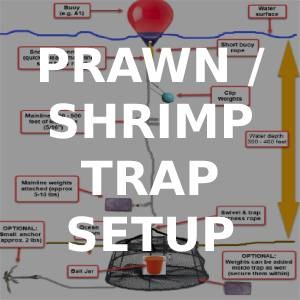


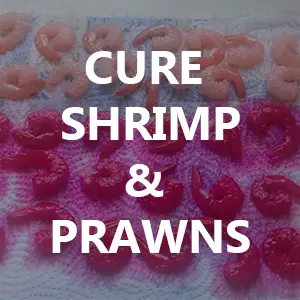
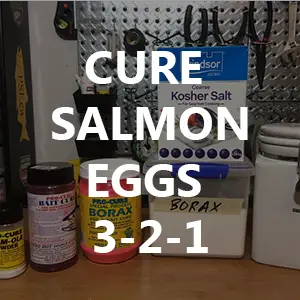







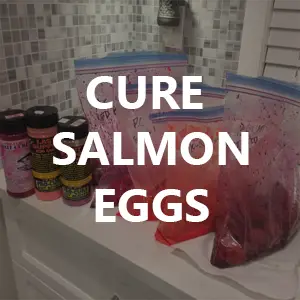



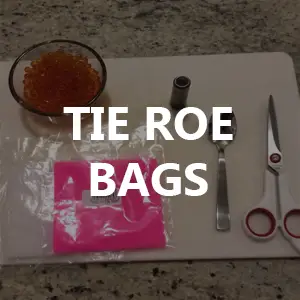





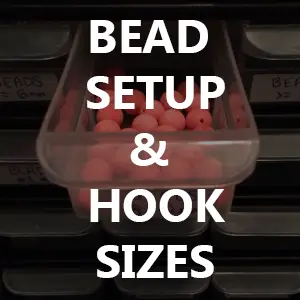


SALT CURE SALMON EGGS RECIPE
FAQ
FAQ
What is the best way to cure salmon eggs?
Place the eggs in a plastic bowl or container to add the cure. In a plastic bag I mix the one part Pink Fire Cure, one part Red Fire Cure, half part sugar and half part borax (many anglers use Natural BorX O Fire for this). After the ingredients are thoroughly mixed together, they are ready to sprinkle onto the eggs.
How to salt cure roe?
Youll want to clean the egg skein in hot water, removing the membrane. Rinse in cold water, set it aside. In a different container mix about 3 cups of filtered water and 1/2 cup salt until dissolved. Put the eggs in the brine, and let sit until you are happy with the salt level.
How do you brine salmon eggs?
- Step 1: Dissolve Salt Into Water. Add 1 cup of salt per skein into water that’s slightly warmer than room temperature. ( …
- Step 2: Add Skeins to Salt Water. Rinse off your skein, and then add it to the salt water solution. …
- Step 3: Remove Eggs From the Brine and Skein. …
- Step 4: Add Flavors.
